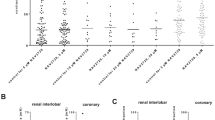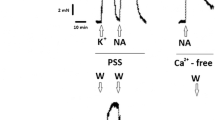Abstract
Despite its very potent vasodilating action in vivo, acetylcholine (ACh) does not always produce relaxation of isolated preparations of blood vessels in vitro. For example, in the helical strip of the rabbit descending thoracic aorta, the only reported response to ACh has been graded contractions, occurring at concentrations above 0.1 µM and mediated by muscarinic receptors1,2. Recently, we observed that in a ring preparation from the rabbit thoracic aorta, ACh produced marked relaxation at concentrations lower than those required to produce contraction3,4 (confirming an earlier report by Jelliffe5). In investigating this apparent discrepancy, we discovered that the loss of retaxation by ACh in the case of the strip was the result of unintentional rubbing of its intimai surface against foreign surfaces during its preparation. If care was taken to avoid rubbing of the intimai surface during preparation, the tissue, whether ring, transverse strip or helical strip, always exhibited relaxation to ACh, and the possibility was considered that rubbing of the intimai surface had removed endothelial cells4. We demonstrate here that relaxation of isolated preparations of rabbit thoracic aorta and other blood vessels by ACh requires the presence of endothelial cells, and that ACh, acting on muscarinic receptors of these cells, stimulates release of a substance(s) that causes relaxation of the vascular smooth muscle. We propose that this may be one of the principal mechanisms for ACh-induced vasodilation in vitio. Preliminary reports on some aspects of the work have been reported elsewhere4,6.
Similar content being viewed by others
References
Furchgott, R. F. Pharmac. Rev. 7, 183–265 (1955).
Furchgott, R. F. & Bhadrakom, S. J. Pharmac. exp. Ther. 108, 129–143 (1953).
Furchgott, R. F., Davidson, D. & Lin, C. I. Blood Vessels 16, 213 (1979).
Furchgott, R. F. & Zawadzki, J. V. Pharmacologist 21, 271 (1979).
Jelliffe, R. W. J. Pharmac. exp. Ther. 135, 349–353 (1962).
Furchgott, R. F. & Zawadzki, J. V. Fedn Proc. 39, 581 (1980).
Furchgott, R. F., Ehrreich, S. J. & Greenblatt, E. J. gen. Physiol. 44, 499–519 (1961).
Poole, J. C. F., Sanders, A. G. & Florey, H. W. J. Path. Bact. 75, 133–143 (1958).
Jaffe, E. A., Nachman, R. L., Becker, C. G. & Minick, C. R. J. clin. Invest. 52, 2745–2756 (1973).
DeMey, J. G. & Vanhoutte, P. M. Archs int. Pharmacodyn. Thér. 234, 339 (1978).
Flower, R. J. Pharmac. Rev. 26, 33–67 (1974).
Flower, R. J. & Blackwell, G. C. Biochem. Pharmac. 25, 285–291 (1976).
Higgs, G. A. et al. Abstr. 7th int. Congr. Pharmac., 334 (Pergamon, Oxford, 1978).
Rand, M. J. & Varma, B. Br. J. Pharmac. 38, 758–770 (1970).
Hume, W. R., DeLalande, I. S. & Waterson, J. G. Eur. J. Pharmac. 17, 227–233 (1972).
Steinsland, O. S., Furchgott, R. F. & Kirpekar, S. M. J. Pharmac. exp. Ther. 184, 346–356 (1973).
Vanhoutte, P. M. Circulation Res. 34, 317–326 (1974).
Löffelholz, K. & Muscholl, E. Naunyn-Schmiedebergs Arch. exp. Path. Pharmak. 265, 1–15 (1969).
Author information
Authors and Affiliations
Rights and permissions
About this article
Cite this article
Furchgott, R., Zawadzki, J. The obligatory role of endothelial cells in the relaxation of arterial smooth muscle by acetylcholine. Nature 288, 373–376 (1980). https://doi.org/10.1038/288373a0
Received:
Accepted:
Issue Date:
DOI: https://doi.org/10.1038/288373a0
- Springer Nature Limited
This article is cited by
-
The underlying mechanisms of DNA methylation in high salt memory in hypertensive vascular disease
Scientific Reports (2024)
-
Histamine H2-receptor antagonism improves conduit artery endothelial function and reduces plasma aldosterone level without lowering arterial blood pressure in angiotensin II–hypertensive mice
Pflügers Archiv - European Journal of Physiology (2024)
-
Endothelium-dependent vasorelaxation effects of F5 fraction of Crinum amabile chloroform extract
Beni-Suef University Journal of Basic and Applied Sciences (2023)
-
Effect of aerobic and resistance exercise training on endothelial function in individuals with overweight and obesity: a systematic review with meta-analysis of randomized clinical trials
Scientific Reports (2023)
-
Cholinergic control of Th17 cell pathogenicity in experimental autoimmune encephalomyelitis
Cell Death & Differentiation (2023)





